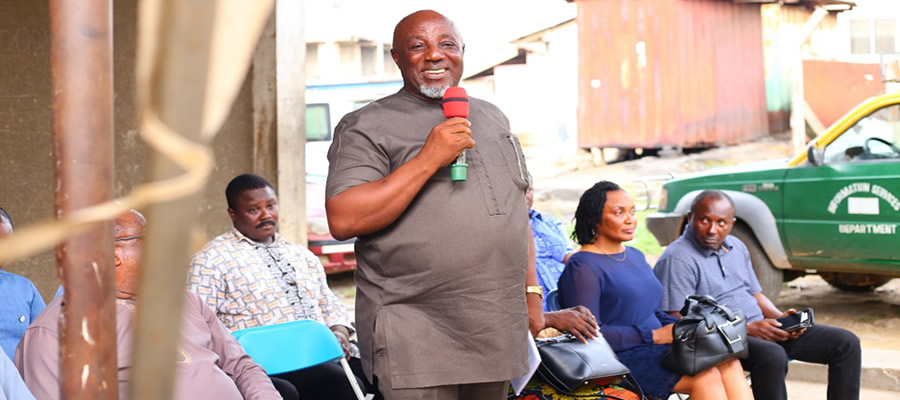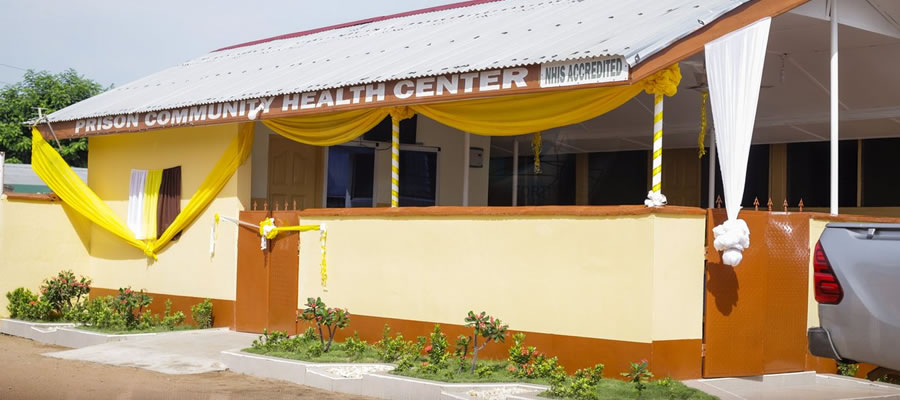

Main Source of Water for Drinking and for other Domestic Use
Main Source of Drinking Water for Households
Table 8.10 shows the percentage distribution of the main sources of drinking water for households in the Municipality. In all, 16,061 representing 32.5 percent have pipe borne water in their dwellings as their main source of drinking water. It further reveals that sachet water, pipe born outside dwelling, public tap, protected well are the main source of drinking water for most of the population in the Municipality. For instance, 20.5% of households use sachet water for drinking, 19.6 percent rely on pipe-borne outside their dwellings.
There exist almost one- tenth of the households using protected well as their main source of drinking water, 8.7 percent rely on public tap/ standpipe for their drinking water. . Very few households still use river/stream (1.5%) for drinking , followed by rain water (1.0%), and bottled water (0.5%). Table 8.9 further reveals that dugouts/ pond/ lake/dam/canal and tanker supply /vendor constitute the least source of drinking water in the Municipality.
Main Source of Water for Domestic Use
Domestic water supply in Ghana competes with a rising demand for water by expanding industry and agriculture sectors. Ghana aims at achieving 85% coverage for water supply by 2015, which would exceed the Millennium Development Goals (MDGs) target of 78% (en. Wikipedia.org / Water supply and sanitation).
Table 8.11 presents the main sources of water for other domestic use in the Municipality. The major water source for households is pipe-borne water inside the dwelling (35.2%), protected well (28.0%), bore-hole/ pump/ tube well (8.8%), pipe-borne water outside the dwelling (15.2%), public tap or standpipe (6.7%) and river or stream (2.8%).
As shown in Table 8.10, there are also wide variations in the main source of water supply for other domestic use between urban and rural localities. The main source of water in the urban areas are pipe borne water inside dwelling and protected well whilst in rural areas it is water from rivers/streams, protected well and borehole/pump/Tube wells. The proportion of urban dwelling units that use pipe-borne inside dwelling is 37.1 percent as against 6.4 percent in the rural areas. The proportion of households using protected wells in the urban areas are 28.2%.
Most rural settlements traditionally rely on raw surface water from such sources as streams, rivers, springs among others for their domestic or household chores . Some of these surface water sources are heavily polluted, resulting in water – borne diseases.
On the basis of the 2010 Population and Housing Census, it is observed in figure 8.1 that a very significant proportion of rural households depend on surface water sources for their domestic chores. It is also noted that whilst one fourth of the rural households depend on bore-holes/pump/ tube water, and one fifth of them depend on protected wells, almost one-tenth of them depend on public tap/standpipe for their water supply for domestic use. The percentage of the households which depend on pipe-borne outside dwelling are more than households using pipe –borne inside dwelling for domestic chores.
Bathing and Toilet facilities
Toilet facilities use by households
Table 8.12 presents the distribution of households by type of toilet facilities in the Municipality. More than 35.9% households use the public toilet. Also, 30.3% of the households use water closets (W.C) facilities. Whereas 16.9 percent use the KVIP, there are 13.1 percent of the households who still use Pit latrines. Despite the urbanized characteristic of the Municipality, almost three percent (2.9%) of the households have no facilities hence resort to the “free- range system”.
There exist disparities in the use of toilet facilities in the urban and rural localities. For instance, the main toilet facility used by rural households is the Pit latrine (38.9%) whilst in urban households the use the Public toilet is represented by (36.2%). There are more urban households who use the W.C (31.5%) as compared to rural households (11.8%). With regards to the use of KVIP, 17.3% of households in urban areas use the facility with 11.2% for rural households. Unsurprisingly, more rural households still use the “free-range” system (5.8%) as compared to urban households of 2.7 percent.
Bathing facility use by households
There are clear differences between households in rural-urban localities and the types of bathing facilities used. Fifty percent (50.6%) of households in urban localities use the shared separate bathroom in the same house as compared to 22.4 percent of households in rural localities. . There are relatively more households in rural areas (29.9%) that have their own bathrooms for exclusive use as compared to the proportion of urban households (23.3%).
Households in rural localities who use shared cubicle are 23.2 percent whilst urban households who use similar facility are 18.6%. Some households still use the open space for bathing in both the urban and rural areas. The case is however more pronounced in the rural areas than the urban areas. For instance in the rural locality almost 15 percent of households use the open space around their houses for bathing with about three percent (2.6%) of the urban households using the same facility.
Figure 8.2 presents the distribution of bathing facility types in households in the Municipality. The use of shared separate bathrooms in the same compound is more pronounced among households in the Municipality compared to the other facilities as shown by figure 8.2. Large number of households also report as using their own bathrooms. Almost one fifth of the Municipal households use shared open cubicles for bathing whilst very small proportion of households use the private open cubicle and the open space for bathing.
Methods of Waste disposal
Waste management is arguably the most crucial environmental challenge facing Ghanaian communities and therefore the need for sustainable waste management approaches cannot be overemphasized.
Method of Solid Waste disposal
Table 8.13 shows the methods by which solid waste is disposed by households in the Municipality. More than half (61.3%) of households in the Municipality use the public dump (container) as their method of solid waste disposal. Burning of solid waste as a method of waste disposal is used by almost 13 percent of households whilst about 11 percent of households use the public dump (open space). Close to ten percent of households dispose their solid waste through collection vendors, also less than five percent (4.4%) bury their solid waste.
The method of waste disposal for urban areas ranges from 64.1 percent of households for public dump (container) to 11.8 percent of households for burning of waste. Collection of solid waste is used by 9.2 percent of households whilst 8.8 percent of households bury their solid waste in the urban localities. However the indiscriminate dumping of solid waste is very low representing (1.6%). In the rural localities , 36.1 percent of households use the public dump (open space) to dispose their solid waste; this is followed by 29.1 percent of households who use the burning method. Public dump (container) as a method of waste disposal is used by 16.7 percent of households in the rural areas. The house to house collection method is the least reported method of solid waste disposal since only three percent of households in rural areas use the method.
Method of Liquid Waste Disposal
Table 8.13 shows the methods by which liquid waste is disposed by households in the Municipality. More than one- third (39.0%) of households in the Municipality dispose their liquid waste into the gutters. Throwing of liquid waste into compound is used by 25.1 percent of households whilst 15.3 percent of households throw it onto the street. Over one tenth of households (13.7%) throw their liquid waste through drainage system into gutters for disposal whilst almost three percent (2.8%) of households use the sewerage system for liquid disposal.
The method of liquid waste disposal for urban areas ranges from 4.4 percent of households throwing their waste into gutter to 23.3 percent for households who through onto the compound. Throwing of liquid waste onto the street/outside represented 14.8 percent of households whilst 14.3 percent of households throw waste through drainage system into a gutter in the urban localities.
However disposing waste through the sewerage system is reported as the least method by households (3.0%). In the rural dwellings, 52.8 percent of households throw waste onto the compound whilst 23.8 percent throw waste onto the street; this is followed by 16.6 percent of households who throw waste into the gutters. Disposing waste through drainage system into gutter as a method of waste disposal is used by 4.1 percent of households in the rural areas. The sewerage system is the least reported method of liquid waste disposal since only 0.5 percent of households in rural areas use the method.
Date Created : 11/26/2017 4:11:28 PM













 facebook
facebook
 twitter
twitter
 Youtube
Youtube
 +233 593 831 280
+233 593 831 280 0800 430 430
0800 430 430 GPS: GE-231-4383
GPS: GE-231-4383 info@ghanadistricts.com
info@ghanadistricts.com Box GP1044, Accra, Ghana
Box GP1044, Accra, Ghana